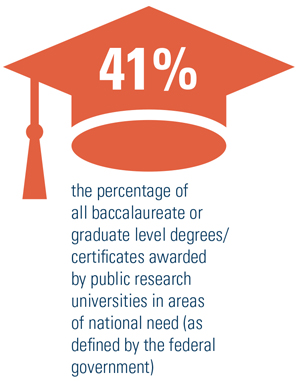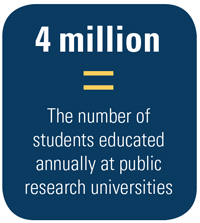Introduction

In an interconnected and rapidly changing world, the United States
requires an educated citizenry to support a constant flow of research and innovation
and to sustain its international competitiveness. Public research universities are
a foundational piece of the U.S. educational infrastructure that meets this need.
A 2012 report to the president and to Congress defines public research universities
as “research intensive,
 doctorate-granting
institutions that receive a share of funding from state and local appropriations
and serve as a critical component of the overall higher education landscape.”1 In 2013, public research
universities enrolled approximately four million students nationwide—an average
of about eighty thousand students in each state.2 These institutions provide high-quality
educational opportunities to students at all income levels. Further, public research
universities enroll the best and brightest students in every state: 87
percent of entering freshmen are from the top half of their graduating high school
class.3
doctorate-granting
institutions that receive a share of funding from state and local appropriations
and serve as a critical component of the overall higher education landscape.”1 In 2013, public research
universities enrolled approximately four million students nationwide—an average
of about eighty thousand students in each state.2 These institutions provide high-quality
educational opportunities to students at all income levels. Further, public research
universities enroll the best and brightest students in every state: 87
percent of entering freshmen are from the top half of their graduating high school
class.3
Nearly 75 percent of all students enrolled in postsecondary programs in the United States attend public institutions, ranging from two-year community colleges to comprehensive four-year baccalaureate- and master’s-conferring state schools to doctoral degree–granting research universities.4 Public research universities serve a distinct and indispensable role in this educational landscape. In addition to producing research and scholarship, public research universities provide economic development and technical assistance to their communities, states, and nation, as well as opportunities for anchor-institution collaborations. While other institutions may address these needs individually, public research universities are charged with addressing them together as effectively, efficiently, and affordably as possible.
 There is at least one public research university in every state, providing geographically
accessible educational opportunities to Americans across the country. Public research
universities initiate the fundamental research that drives scientific and technological
discovery. They educate and train the skilled workforce of tomorrow. They prepare
schoolteachers and faculty for the classroom. They equip the next generation of
leaders with the knowledge, skills, and empathy to lead a twenty-first-century democracy.
Most important, public research universities are stewards and repositories of human
knowledge.
There is at least one public research university in every state, providing geographically
accessible educational opportunities to Americans across the country. Public research
universities initiate the fundamental research that drives scientific and technological
discovery. They educate and train the skilled workforce of tomorrow. They prepare
schoolteachers and faculty for the classroom. They equip the next generation of
leaders with the knowledge, skills, and empathy to lead a twenty-first-century democracy.
Most important, public research universities are stewards and repositories of human
knowledge.
 Today, confronted with reduced state investment, public research universities are
forced to make difficult choices about institutional priorities. In this climate,
the American Academy of Arts & Sciences created the Lincoln Project: Excellence
and Access in Public Higher Education to urge support for public research universities
and recommend new strategies to sustain these critical institutions. This report
begins the discussion by demonstrating the many ways in which public research universities
are a vital public good.
Today, confronted with reduced state investment, public research universities are
forced to make difficult choices about institutional priorities. In this climate,
the American Academy of Arts & Sciences created the Lincoln Project: Excellence
and Access in Public Higher Education to urge support for public research universities
and recommend new strategies to sustain these critical institutions. This report
begins the discussion by demonstrating the many ways in which public research universities
are a vital public good.
ENDNOTES
1 National Science Board, Diminishing Funding and Rising Expectations: Trends and Challenges for Public Research Universities (a companion to Science and Engineering Indicators 2012) (Arlington, Va.: National Science Foundation, 2012), http://www.nsf.gov/nsb/sei/companion2/files/nsb1245.pdf. For the purposes of this project, public research universities are defined as institutions that are Carnegie-classified as Very High Research Activity or High Research Activity as of 2014, are located in one of the fifty states, and educate undergraduate students. See National Center for Education Statistics, IPEDS [Integrated Postsecondary Education Data System] (U.S. Department of Education, Institute of Education Sciences), https://nces.ed.gov/ipeds/.
2 National Center for Education Statistics, IPEDS.
3 Additionally, 61 percent of first-time, full-time freshmen come from the top quarter of their graduating high school class, and 35 percent come from the top fifth of their graduating high school class. See U.S. News & World Report, U.S. News College Compass (2015).
4 National Center for Education Statistics, “Digest of Education Statistics,” Table 303.10, “Total Fall Enrollment in Degree-Granting Postsecondary Institutions, by Attendance Status, Sex of Student, and Control of Institution: Selected Years, 1947 through 2023” (U.S. Department of Education, Institute of Education Sciences), http://nces.ed.gov/programs/digest/d13/tables/dt13_303.10.asp.
5 National Center for Education Statistics, IPEDS.